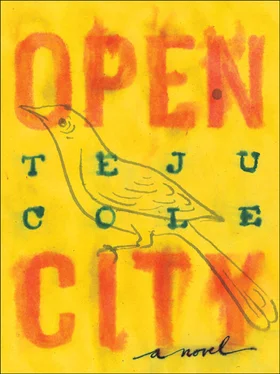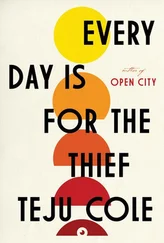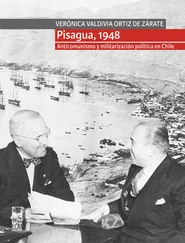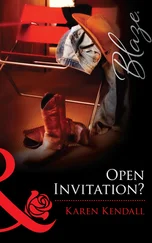Following Cabrini a few hundred yards farther, to its farthest extent, would have brought me to Fort Tryon Park, in which was nestled, like a jewel in velvet, the Cloisters museum. I remembered my last visit to the museum, when I had come with my friend. We’d stood in the walled garden, which overlooks the Hudson. There was a large espaliered pear tree, shaped into a kind of green candelabrum against the stone wall, its branches, ramified like those on the Tree of Jesse, had been forced through the years by the attentions of gardeners into right angles and a single, two-dimensional plane. At my feet were the various herbs typical to a monastery plot — marjoram, parsley, marshmallow, garden sorrel, leek, red valerian, sage. They grew freely, thriving so well that we talked about how wonderful it would be to have a kitchen garden identical to this one.
I remember how, on that day, I knelt down close to the herb plot and inhaled its thin fragrance. The plot contained soapwort and liverwort, herbs that had been given their names by the old wisdom of simpling, or sympathetic herbal medicine, a quasi-mystical art by which the medicinal properties of plants were related to their physical appearance. Liverwort was thought to be good for liver ailments because its leaves evoked the shapes of the lobes of the liver; lungwort, likewise, was good for breathing complaints because its leaf was shaped like a lung; and soapwort was valued for its dermatological uses. This is where the search for meaning had led our medieval ancestors: to the certainty that God, who made all of creation, had scattered clues to the useful functions of created things in those things, and that only a little vigilance was necessary to decode those clues. Simpling was but the most basic of this kind of learning; the search for Signs, as undertaken by the sixteenth-century German humanist Paracelsus, was a further extension of the same idea.
For Paracelsus, the light of nature functioned intuitively, but it was also sharpened by experience. Properly read, it informed us what the inner reality of a thing was by means of its form, so that the appearance of a man gave some valid reflection of the person he really was. The inner reality is, indeed, so profound that, for Paracelsus, it cannot help but be expressed in the external form. On the other hand, as in the case of artists, unless the work of art addressed the question of an inner life, its external Signs would be empty. And so, Paracelsus developed a fourfold theory around how the light of nature is manifest in individual men: through the limbs, through the head and face, through the form of the body as a whole, and through bearing, or the way a man carries himself.
We are familiar with this theory of Signs in the debased forms of phrenology, eugenics, and racism. However, this sensitivity to the play between inner spirit and outer substance also underpinned the success of many of the artists of Paracelsus’s time, not least the wood sculptors of southern Germany. By showing an extreme attentiveness to the properties of wood, and to how those properties might be translated into sculptural character, they created enduring works of art, precisely of the kind that lined the rooms and halls of the Cloisters. Riemenschneider, Stoss, Leinberger, and Erhat brought a complicated material knowledge of lindenwood to bear on their carving of it, and their attempts to marry the spirit of the material with its visible form, craftlike though it is, is after all not so different from the diagnostic struggle that doctors are engaged in. This is particularly true in the case of those of us who are psychiatrists, who attempt to use external Signs as clues to internal realities, even when the relationship between the two is not at all clear. So modest is our success at this task that it is easy to believe our branch of medicine is as primitive now as was surgery in Paracelsus’s time.
On that day, with these thoughts of Signs and simpling in mind, I had tried to give my friend an account of my evolving view of psychiatric practice. I told him that I viewed each patient as a dark room, and that, going into that room, in a session with the patient, I considered it essential to be slow and deliberate. Doing no harm, the most ancient of medical tenets, was on my mind all the time. There is more light to work with in externally visible illnesses; the Signs are more forcefully expressed, and therefore harder to miss. For the troubles of the mind, diagnosis is a trickier art, because even the strongest symptoms are sometimes not visible. It is especially elusive because the source of our information about the mind is itself the mind, and the mind is able to deceive itself. As physicians, I said to my friend, we depend, to a much greater degree than is the case with nonmental conditions, on what the patient tells us. But what are we to do when the lens through which the symptoms are viewed is often, itself, symptomatic: the mind is opaque to itself, and it’s hard to tell where, precisely, these areas of opacity are. Ophthalmic science describes an area at the back of the bulb of the eye, the optic disk, where the million or so ganglia of the optic nerve exit the eye. It is precisely there, where too many of the neurons associated with vision are clustered, that the vision goes dead. For so long, I recall explaining to my friend that day, I have felt that most of the work of psychiatrists in particular, and mental health professionals in general, was a blind spot so broad that it had taken over most of the eye. What we knew, I said to him, was so much less than what remained in darkness, and in this great limitation lay the appeal and frustration of the profession.
I FOUND THE RIGHT BUILDING, AND JOHN SPOKE TO ME ON THE intercom, and let me in. I took the elevator up to the twenty-ninth floor. He was at the door, wearing an apron. Come on in, he said, it’s nice to meet you in person finally. There were quite a few people there already. John was a hedge fund trader, quite wealthy already, to judge from the house, which was spacious and rather richly decorated with mid-century modern furniture, an assortment of kilim rugs, and a Fazioli grand piano. I estimated he was about fifteen years older than Moji was. There was something forced in his gregariousness, and the ruddy pink cheeks and salt and pepper goatee did not appeal to me. Moji came up to me, and we embraced. What’s with the bandage? she said. You’ve taken up boxing or what? I mumbled something about slipping on a threshold, but she had already gone into the kitchen. From there she called out, asking what I wanted to drink. I shouted an answer, unsure of what it was even before the echo of my voice faded, as my mind was still on how beautiful she looked, how desirable and, of course, unavailable.
BY ABOUT 2:00 A.M., MANY PEOPLE HAD LEFT, AND THE PARTY quieted down. Someone replaced the electronic dance music that had been playing on the stereo with a recording of Sarah Vaughan with strings. The dozen or so guests that remained were all sprawled on the sofas. A few were smoking cigars; the smell was pleasant, seductive, a baritone fragrance that evoked feelings of equanimity in me. One couple slept in each other’s arms, and a girl with heavy black eye shadow was curled up on the carpet near them. Moji and John were deep in conversation with an Italian physicist. He was from Turin. His wife, a woman from Cleveland, whom I had met earlier, was also a physicist. There had been something about both her delayed reaction in conversation and the slightly odd way she spoke that had made me wonder if she was deaf. Naturally, it wasn’t possible to ask, and I let the matter slide. I had spoken to her and her husband for a while. She’d been happy to get into a discussion about Italo Calvino and Primo Levi with me; he’d seemed bored and, on the pretext of going to refill his drink, had drifted away.
Читать дальше












